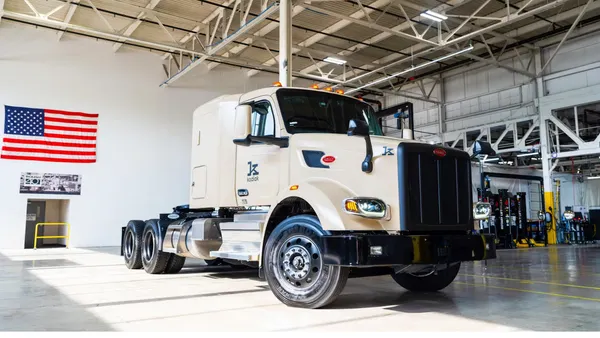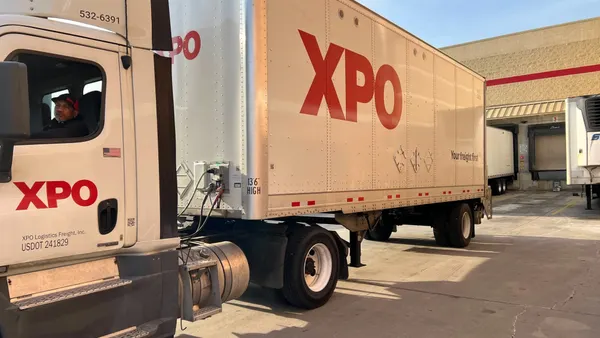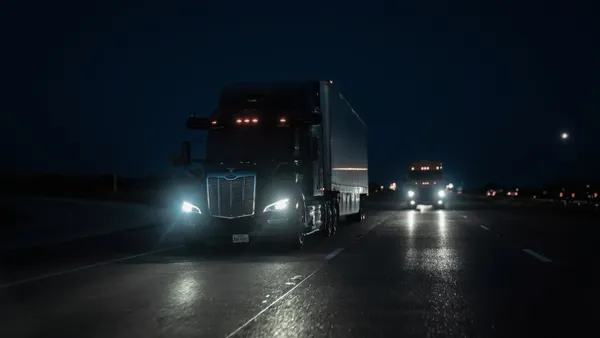Dive Brief:
- For handling business tasks, the perfect balance of technology and humans is 44% humans and 56% technology, according to a survey of 800 supply chain and transport decision-makers conducted by Coyote Logistics.
- This marks a shift of three percentage points in favor of humans — reported by carriers and shippers — compared to the 2019 version of the survey. "With such an incredible global trend pushing digital adoption, surely the balance would move further towards technology, right? Not quite," reads the report.
- Fleets' technology/human balance preference shifted away from technology and toward people, compared to 2019 results, for five tasks: resolving delivery problems, load scheduling, communicating with brokers and third-party logistics partners, obtaining quotes/negotiating prices, and communicating with customers.
Dive Insight:
Mandatory social distancing and pandemic-driven shutdowns forced businesses around the globe to rely more heavily on digital tools. From electronic bills of lading to remote office environments, the coronavirus accelerated technology adoption, in many cases.
The Coyote study, however, showed trucking leadership is more interested in a blend of humans and technology to carry out duties.
"After a year of remote work, the logistics industry has become much more comfortable with digital communication — but there is still a strong demand for a person when they're needed," the report said.
Ability to invest in technology, previously the No. 3 challenge for carriers in 2019, fell to No. 6 in 2021. Access to a real person when issues arose moved from No. 9 in 2019 to No. 5, indicating fleets are more concerned with communicating with the right people than access technology.
| Top tasks with a preference for humans | Top tasks with a preference for technology |
|---|---|
| Resolving delivery problems | Analysis and distillation fo data into actionable takeaways |
| Load scheduling* | Booking loads |
| Communicating with brokers and third-party logistics partners | Projecting what revenue should be |
| Obtaining quotes/negotiating prices | Maintaining profitability |
| Communicating with customers | Load scheduling* |
*Survey respondents put load scheduling in both categories. "There is no clear consensus on the best way to achieve any task. The most dominant theme is that people still play a major role," the report said.
SOURCE: Coyote Logistics
"A correction for a technology binge" may be the driving force behind the five tasks that shifted away from technology and toward humans, Coyote said. In 2019, route planning and load scheduling were the top two technology tasks, and they each shifted toward people in 2021.
The roller coaster of a freight market brought on by the pandemic could also be contributing to that trend. Digital brokerage, for example, has been gaining steam and demand for capacity surges. But all that activity has emphasized the importance of building relationships — a task at which humans excel.
"If [carriers] don't trust you, they will go elsewhere," Justin Frees, chief capacity officer of Arrive Logistics, said last month.
Of the carrier professionals surveyed, 42% were from the U.K., while 37% were from the U.S. More than half had between four and 50 trucks, while 29% had more than 50 and 16% had fewer than four. But there was still general consensus across shippers and carriers around the slightly greater preference for technology over humans overall — save for two carrier demographics.
Carriers in the U.S. with fewer than three trucks favored humans more than technology (58% and 42%, respectively). And Canadian carriers with four or more trucks had a higher preference for technology (69%, compared to 31% human).
"Even these two groups were not true outliers; just slightly more inclined towards people and technology, respectively," the report said. "Regardless of any business's specifics, if their strategy doesn't include a healthy blend of the two, it is out of sync with industry trends."











